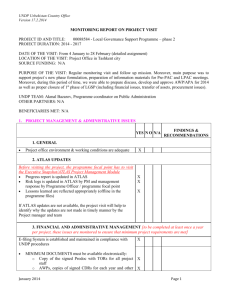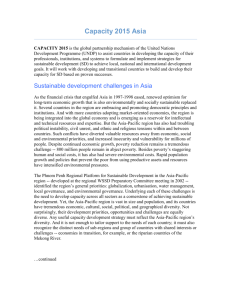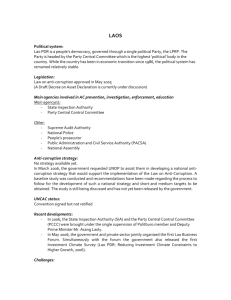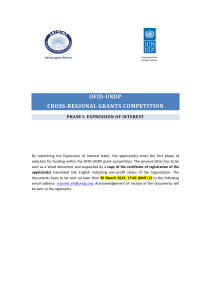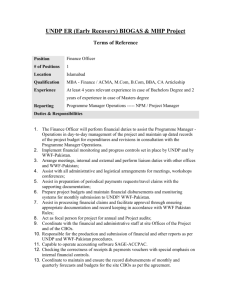Hall 1 The UN Millennium Declaration: The UN`s Sustainability
advertisement
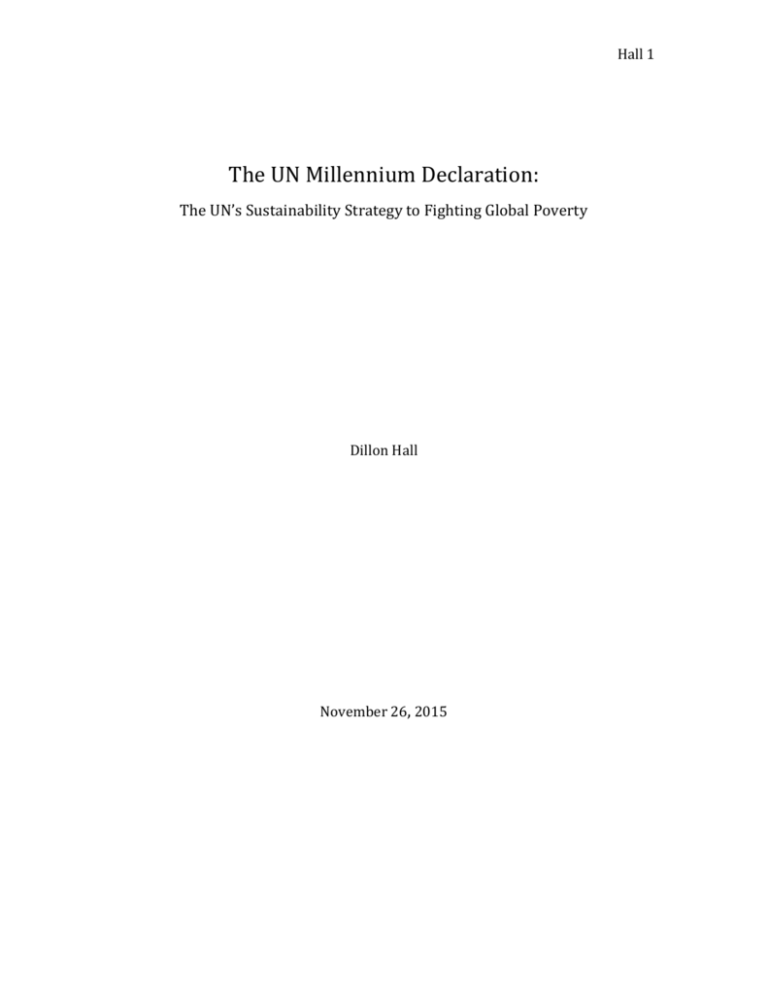
Hall 1 The UN Millennium Declaration: The UN’s Sustainability Strategy to Fighting Global Poverty Dillon Hall November 26, 2015 Hall 2 After recognizing the importance of establishing an approach to poverty that incorporates environmental responsibility, the United Nations (UN) adopted the UN Millennium Declaration, a “global agenda of eight development goals, known as the Millennium Development Goals (MDGs), for cutting world poverty in half by 2015.”1The innovative approach has dramatically curbed poverty throughout the globe while simultaneously adapting to ongoing environmental changes.Established in 2000, the plan designated 2015 as the desired year to achieve its goals2.When 2015 came around, more than 150 leaders from across the world met at the UN headquarters in New York City and agreed upon a new framework of developmental goals.This paper will begin by describing the Millennium Development Goals; it will then explore the effects the plan has had on certain countries;and,finally, briefly dive into the new goals that the UN has established in the fall of 2015. The eight Millennium Development Goals sought to dramatically decrease poverty rates globally while still setting forth an environmentally sustainable path for the future.The goals were widely known as the “first of a kind” because of the wide, multi-dimensional approach they shared toward addressing poverty3.Unlike previous approaches, the Millennium Development Goals emphasized hunger, 1 See World Resources 2005 to read an in-depth analysis of the establishment, specifics, and shortcomings of the UN millennium Declaration. 2 See UN 2015’s Report about the 2030 Agenda for Sustainable Development to learn about the final outcomes of the Millenium Declaration.Furthermore, the report explains the many ways that the results affected the 2015-2030 plan and the changes that were necessitated due to the report. 3 Again, see World Resources 2005. Hall 3 disease, lack of shelter, gender equality, education and environmental sustainability—all in an actionable, pragmatic manner.The goals consisted of a timed target with incremental goals prior to the deadline.In addition, the Millennium Development Goals required countries to prepare progress reports, instituting a new and evolved level of cooperative transparency. Below are the Millennium Development Goals: Goal 1: Eradicate extreme poverty and hunger Goal 2: Achieve universal primary education Goal 3: Promote gender equality and empower women Goal 4: Reduce child mortality Goal 5: Improve maternal health Goal 6: Combat HIV/AIDS, malaria, and other diseases Goal 7: Ensure environmental sustainability Goal 8: Develop a global partnership for development Overall, the eight goals mitigate a diverse array of oppressive structures globally.While most poverty reduction plans would center upon solely Goal 1 (to eradicate extreme poverty and hunger), the Millennium Development Goals go beyond such a simple approach and improve societal wellness in a variety of ways.In addition, the explicitness of the goals allows the UN to hold countries accountable for accomplishing the goals.According to experts,“[b]y stating goals … in clear, straightforward language, the MDGs make it easy for civil-society groups to evaluate progress toward human development goals and to issue a public “report card” on a government’s success or failure.”4The language of the goals and its 4 See Footnote 1. Hall 4 specificity enable the UN to more easily pressure the globe to accomplish the goals, making them more unique compared to other poverty mitigation strategies. The next section of this paper will explore the effects that the Millennium Development Goals have had on certain countries, primarily focusing upon individual instances of success.This section will present specific examples of economic success that resulted from the United Nation’s Millennium Development Goals, which increased revenue for the working, impoverished people of growing nations.The countries that this paper will focus on include: China, Uzbekistan,the Republic of Malawi,and Venezuela. China and Tea Farms With its strong influence in the United Nations, China’s role in promoting economic sustainability and its partnership with the United Nations Development Plan (UNDP), the primary actor for ensuring the Millennium Development Goals are followed through, is critical.One primary area of cooperation between China and the UNDP involves the farming of green tea, an agricultural product that historically makes up a massive component of China’s economy.5Through the cooperation and based off of the Millennium Development Goals, the UNDP and Xinyang Municipal Government of the Henan Province were able to establish 18 eco-friendly local government guidelines and mechanisms,review 374 policies in Xinyang municipals leading to the amendment of 7 environmentally damaging agriculture and forestry 5 See Sartor’s 2007 article describing the political and economic impact that tea has had on China throughout history. Hall 5 policies, and eventually lead to the creation of the Municipal Land Use Plan for 2010-2020.6 The UNDP worked with the Xinyang Municipal Government in order to launch a pilot program to deal with the restoration and preservation of ecosystems in the Huaihe River Basin.The overall goal was to “address national environmental management and to conserve global biodiversity.”7During the pilot project, the two organizations were able to develop a mechanism for massively promoting and protecting land used for growing tea in order to further stimulate China’s economy.The cooperation resulted in the discovery of new production techniques, mitigation of negative environmental impacts, training for tree cropping and infusion, and technical innovation and support.Briefly after receiving the support of the UNDP, one farmer noted,“a 10 percent increase in production this year and …more leaves that could meet the premium level standard.”8By the end of the fiveyear project, Xinyang contained up to 11 safe and sustainable tea production sites, 6 See the UNDP’s 2014 article that explains thoroughly its cooperation with the Xinyang Municipal Government of the Henan Province.This article goes into detail about agricultural cooperation between the UN and Xinyang officials and the direct correlation that these had with the UN’s sustainable development goals.In addition, the article goes into detail about the program’s effectiveness in providing income to the poor within the region of China. 7 This is from later on in the UNDP 2014 article that describes the cooperation between the two official bodies. 8 This quotation is from a farmer named Li, who lives in the Huaihe region and was able to go from living an impoverished life to gaining massive revenues.The quotation is toward the middle of the UNDP 2014 article. Hall 6 benefiting China’s economy and paving the way toward an ecologically sustainable tea-producing world. Uzbekistan and Beekeeping Despite being a less influential country in the United Nations than China, Uzbekistan still plays an important role in the UNDP and the success of the eight Millennium Declaration Goals due to its drastically increasing impoverished population as the Aral Sea disaster continues to leave fishermen and farmers jobless.The UN cooperated through the UNDP in accordance with the Millennium Development Goals with the Uzbekistan government to launch the joint UN Aral Sea Programme of 2012.The purpose of the program was to establish a new way to revive Uzbekistan’s economy and promote sustainable development, while dramatically reducing the amount of impoverished citizens living in Uzbekistan.The conclusion of the program? Bees. The study concluded that beekeeping would be the perfect economic replacement for Uzbekistan, stimulating its economy by creating a new industry that the poor can easily participate in.9 Beekeeping has an incredibly cheap startup price despite having a consistently high demand, thus the UNDP concluded that it would be the perfect economic replacement for Uzbekistan.Entrepreneurs who want to become involved in the beekeeping business were able to register cheaply and attend UNDP-supported seminars that teach the ambitious citizens how to run a sustainable business and perform a demonstration to receive investments into their beekeeping businesses.Since the program started, over 48 UN-supported 9 See Sherali Suyarkulov’s 2013 article describing the effects of UNDP cooperation with Uzbekistan over beekeeping.The article outlines the economic effects, the details behind the cooperation, and the reasons the two agencies decided upon beekeeping. Hall 7 demonstration projects have occurred in just the Amudarya district, with more than 210 beehives being delivered to hopeful businessmen.However, the UNDP helped the poor people regain an economic footing beyond just the start-up costs.The UNDP also created a network of agro-consultants that would aid and assist rural impoverished populations in becoming a part of the sustainable, beekeeping practice.The results of the cooperation were fantastic.According to the UNDP website,“[t]he UN Aral Sea Programme helps address the economic, health and food needs of more than 130,000 people directly affected by the environmental crisis, while other community development plans, such as the provision of basic infrastructure, improved social services and healthcare, benefit almost 500,000 people indirectly.”10 Malawi Women and Recycling As a historically patriarchal society, the drastic lack of income for women in the Republic of Malawi is one of the largest problems facing the republic in modern times.11The fundamental barrier to women obtaining revenue is the lack of access to the job market due to the patriarchal ideologies within the society.While it certainly does not enable equality for women in the Republic of Malawi, the UNDP has helped create a massive leap toward female equality in the republic by launching the 10 See the UNDP’s 2013 article that explains the goals, mechanics, and outcomes of cooperation between Uzbekistan’s government and the UNDP.In addition, the article goes into the details of the beekeeping industry’s effect upon the overall Uzbekistan economy. 11 See the Denmark Economic Empowerment Initiative article on empowering women in Malawi. Hall 8 “Waste for Wealth” project.In the republic, over 80% of urban waste is organic and recyclable, holding massive potential to increase not only income for women, but food security for everyone in the country.12 In 2010, the “Waste for Wealth” project begun with the training of just 37 women, starting with the simplistic job of converting compost into fertilizer.13The conversion enables the women of Malawi to not only gain a large amount of revenue directly, but also use the manure-based fertilizer to grow crops for their own uses.The UNDP’s training included teaching women the most effective mechanisms for acquiring the garbage in the region;organizing it into distinct categories based off of the different materials that the trash is made of; sanitizing the materials to get rid of germs; decomposing the materials to turn them into a fertilizer; and finally, bagging the manure fertilizer and selling it to corporations.The project has allowed the formerly unemployed women of Malawi to be able to earn a living wage while simultaneously cleaning the region and promoting the agricultural industry throughout the region.In addition, water-vectored diseases have dramatically diminished in the region due to the enhanced cleanliness of the region.14 12 See UNDP’s 2015 article that explains its “Waste for Wealth” project in the Republic of Malawi.This article goes into in depth detail not only about the project itself, but what instigated the project and the very beneficial outcomes of the project. 13 See Footnote 12. 14 See Charles Mkula’s 2014 article to read a thorough analysis of the pros and cons of the UNDP program in Malawi.The article details a personal narrative, in addition, which may help contextualize the program’s broader effect on the women in Malawi. Hall 9 Not only did the UNDP help set up the basics for Malawi female employment via training the women, but it also provided thousands of dollars toward constructing storage places for the fertilizer.15 As a result, every waste dump in the project areas has been removed.Over 158 new fertilizer entrepreneurs have been trained by the UNDP, and compost sales have amounted to record high levels.Overall, the UNDP program epitomizes the importance of combining economic growth with socially progressive and environmentally friendly initiatives.Not only does the project provide massive amounts of wealth to the Malawi economy, but also it furthers equality for women in the country while simultaneously dramatically benefiting the pollution and agricultural industry of the country. Venezuelan Youth and Music With more than seven percent of its inhabitants living in extreme poverty, the UNDP targeted Venezuela as a key country to employ dramatic sustainable antipoverty measures within.16 However, Venezuela has been known as a nation that is historically against Western imposition.In order to accommodate Venezuela’s antiimperialist desires while simultaneously accomplishing the objectives of relieving poverty throughout the nation, the UNDP decided to promote and invest a significant amount of effort, wealth, and time into a project known as the System of Youth and Children’s Orchestras of Venezuela.The program began in 2002, 15 See Footnote 12. 16See Patricia Clarembeaux’s article about the UNDP’s initiative in Venezuela to learn more about the current situation regarding poverty in the country, as well as to learn further details regarding the UNDP’s musical teaching program in Venezuela. Hall 10 however, is still functioning even today.Poor Venezuelans between the ages of three and 29 are the main demographic targeted by the program, which teaches them the art of music and how to play certain instruments.While at first this may seem to be insignificant toward eradicating poverty, the UNDP has cited many studies that indicate that a musical education “promotes discipline and healthy past-times, thereby setting children on a path to create better lives for themselves and their families.”17 Through the orchestral methodology of the UNDP, students are able to not only work harder toward improving their own lives, but they are able to work harder toward improving their family’s lives. The funding for the Venezuelan program required a partnership with the International Development Bank due to the relatively large amount of funding required for the initiative.The program supplies instruments to 99% of the students, trains them with professional musicians, and even inspires the students with famous musicians.In total, over 350,000 of the Venezuelan youth population have gone through the program and begun living happier and more sustainable lives.While this program doesn’t deal with the UN’s ideal approach toward “sustainability,” which is usually in relation to deterring environmental degradation, this program still meets its goal of sustainability by not contributing in any way, shape, or form toward ongoing environmental devastation.The program begins at the preschool age, giving children the attention that they need but are not able to achieve due to the systemically impoverished structures of the nation.Additionally, 17See Footnote 16. Hall 11 the children are placed in a safe yet challenging environment, teaching them endurance, resilience, a deep sense of value, trust, and confidence.18 Lebanon and Water Scarcities A large focus of this paper has been on the UNDP’s sustainable initiatives in regards to attempting to mitigate environmental damage, whether through the Republic of Malawi’s composting efforts or China’s environmentally friendly tea farming efforts.However, this next section will focus on how Lebanese farmers are fighting the effects of climate change in order to effectively adapt to its damages and successfully maintain their agricultural efforts despite the drastic environmental modifications that are to come in the near future.In the last few decades, the most common months in Lebanon for rain (December, January, and February) have seen roughly a 16% decrease in the amount of precipitation during these months.19 The significance of that number means that there is a substantially smaller amount of well water needed to continue hydrating the crops of farmers, causing an inevitable food crisis. However, in response to this increasing water shortage, the UNDP partnered with the Lebanese Ministry of Environment to provide climate resilient infrastructure to the farmers.The project has implemented rainwater-harvesting systems on top of greenhouses used for growing crops, storing the water in underground storage tanks.While this seems like a modest solution that is 18See El Sistema’s article about their program in Venezuela to further learn about their objectives and the individual training and strategic approaches that the program takes. 19See Assaad Razzouk’s article that thoroughly details the problems being created by climate change in Lebanon. Hall 12 incredibly simple, it more than doubles the amount of water that is harvested by the farmers, increasing the potential for crop growth and fully mitigating the water scarcity effect caused by ongoing environmental changes, such as climate change.20 This project not only dramatically increases crop yields, but it also saves money farmers would have spent on purchasing water, protects the water from pollution and salinization, and preserves the water quantity overtime.In addition, the project reduces the CO2 emissions that are generated from water pumping, serving as a climate-friendly project in the long run.The UNDP, fortunately, did not stop at providing the infrastructure.In fact, the UNDP continued its efforts by creating a guidebook for any farmers that are interested in preserving rain water in such an effective manner, making it available for the broader Lebanese population. 2030 Sustainable Development Goals As mentioned previously, the initial goals established 2015 as the “target year,” or year that the goals were desired to be achieved by.Thus, in 2015, a new plan was needed to extend the initial framework and continue promoting sustainable development in impoverished areas throughout the world.During 2012, a UN meeting occurred named Rio+20, which determined and created a planning commission that would come up with the new sustainable development goals to propose and eventually adopt in the 2015 United Nations meeting.21The 20See UNDP 2015 article that describes thoroughly their program for providing infrastructure and training to Lebanese fighters in order to resolve the problems being created by climate change. 21 See the article published by the United Nations in 2015.This article describes the Rio+20 meeting and its eventual evolution into the adoption of the new sustainable development goals globally. Hall 13 commission then spent over a year negotiating the plan and eventually proposing 17 new goals for the United Nations to adopt.These goals were adopted in August of 2015, with all 193-member states of the UN agreeing that the goals would be ideal for promoting sustainable development between 2015 and 2030.The new framework established 17 distinct goals for countries to achieve; these goals were foundationally the same as the Millennium Development Goals while maintaining a fundamental distinction that set the goals onto a path of unique success. The new goals not only embraced a broader approach than the Millennium Development Goals, but also attempted to eradicate the root causes of poverty and gender inequality, as well as the overall process of development rather than merely the outcomes.The 17 new goals that have been adopted by the UN are as follows22: Goal 1: End poverty in all its forms everywhere. Goal 2: End hunger, achieve food security and improved nutrition, and promote sustainable agriculture. Goal 3: Ensure healthy lives and promote wellbeing for all at all ages. Goal 4: Ensure inclusive and equitable quality education and promote lifelong learning opportunities for all. Goal 5: Achieve gender equality and empower all women and girls. Goal 6: Ensure availability and sustainable management of water and sanitation for all. Goal 7: Ensure access to affordable, reliable, sustainable and modern energy 22See Liz Ford’s 2015 article that describes the creation, implementation, ideals, criticisms, and fundamental problems behind the 2015-2030 sustainable development goals. . Hall 14 for all. Goal 8: Promote sustained, inclusive and sustainable economic growth, full and productive employment, and decent work for all. Goal 9: Build resilient infrastructure, promote inclusive and sustainable industrialisation, and foster innovation. Goal 10: Reduce inequality within and among countries. Goal 11: Make cities and human settlements inclusive, safe, resilient and sustainable. Goal 12: Ensure sustainable consumption and production patterns. Goal 13: Take urgent action to combat climate change and its impacts (taking note of agreements made by the UNFCCC forum). Goal 14: Conserve and sustainably use the oceans, seas and marine resources for sustainable development. Goal 15: Protect, restore and promote sustainable use of terrestrial ecosystems, sustainably manage forests, combat desertification and halt and reverse land degradation, and halt biodiversity loss. Goal 16: Promote peaceful and inclusive societies for sustainable development, provide access to justice for all and build effective, accountable and inclusive institutions at all levels. Goal 17: Strengthen the means of implementation and revitalise the global partnership for sustainable development. The 17 goals were chosen following the conclusion of the open working group’s draft agenda and resulting negotiations at the United Nations throughout 2014.According to the UNDP’s Assistant Administrator and Director of the Bureau for Policy and Programme Support,the “2030 Sustainable Development Agenda is based on the understanding that only economic growth that respects ecological Hall 15 boundaries, fosters social equity and equal access to common goods, and contributes to poverty eradication, is destined to succeed.”23 This indicates that the new goals are consistent with the former goals, only that they recognize the previous short-comings of the 2015 goals and are able to adapt well in order to better stimulate economic growth while promoting social equity, diminishing poverty, and being environmentally responsible. However, despite the plan having a previous 15-years of effort to improve upon, challenges certainly remain.According to the German Minister of the Environment,the primary challenge “is to achieve, as quickly as possible, the paradigm shift to an economic development that finally respects the ecological boundaries of our planet and at the same time eliminates poverty and hunger.”24Despite the UN coming to a consensus on the plan to establish sustainable development, a massive economic paradigm shift will be necessary globally.This will, assumedly, be largely problematic due to the consistent global shift toward and subsequent evolution of capitalism, which promotes a lifestyle of consumption in 23 This quotation comes from Magdy Martínez-Solimán in an article by the UNDP- UNEP Poverty-Environment Initiative that was published in 2015.It is very significant because of how much of an important leader Martínez-Solimán is within the UNDP.The article goes into further details describing the establishment and unique hopes of the 2030 Sustainable Development Agenda based off of being better than the Millennium Development Goals. 24 In 2015, Hendricks, who plays a significant role in the promotion of and compliance to the 2030 Sustainable Development Agenda globally, criticized it thoroughly for a variety of reasons.To go into further detail about Hendricks’ criticism, her arguments can be found on the UN website linked in the bibliography. Hall 16 opposition to environmental responsibility.25To further elaborate without losing the focus of the paper, ongoing globalization enables corporations to frequently ignore environmental regulations, undermining environmental responsibilities in order to widely increase profits.In addition, the United Kingdom and Japan disagree with the implementation of the goals.The two countries agreed that the goals are too complicated and costly to implement, very difficult to convince the public that they are worthwhile goals that are realistic, and would prefer a substantially narrower plan, similar to the 2000 goals.26 In fact, David Cameron has publicly stated that he desires merely 10 goals, however, has not indicated which goals he’d like to be removed from the current plan. The remaining barrier to a successful path to sustainable development, unfortunately, remains the most obvious barrier: money.An intergovernmental committee of experts on sustainable development financing roughly estimated that the goals would cost over seven trillion dollars a year to effectively eradicate global poverty.27 In order to come up with the funding, the committee has suggested not only should the global governments use public financing, but also that the UN can raise a massive amount of the money through the private sector, tax reforms, and further crackdowns on illicit financial flows and corruption.While the problem of financing will cause the goals to be less than as ideal as when they were proposed 25 In their article about neoliberalism, Parker& Prudham point out the fundamental incompatibilities of the growing forces behind capitalism and attempts at preserving the environment through actions labeled as “sustainable.” 26See 27 Footnote 17. See Footnote 21. Hall 17 and agreed upon, the goals have still been adopted by the UN and will become applicable starting in January of 2016.Even if there is a shortage of financing, the UN will still be able to successfully diminish poverty globally—just not necessarily eliminate it. In conclusion, the United Nations has led a very successful campaign to promoting sustainable poverty eradication globally between 2000 and 2015.Specifically, in the period between 2003 and 2015, the United Nations Millennium Declaration Goals guided the UN Development Group to hugely successful initiatives in regions of China, Uzbekistan, the Republic of Malawi, Venezuela, and Lebanon.The UN has lead the first global movement to not only diminishing poverty on a large scale, but also simultaneously promoting responsibility toward the global climate.In 2015, the Millennium Declaration Goals expired and the UN adopted a new set of goals known as the 2030 Sustainable Development Agenda.These new goals attempt to confront the problems associated with the Millennium Declaration Goals, yet bring with them some additional problems.The real question remains whether the UN’s 2030 Sustainable Development Agenda will be able to eradicate poverty, while mitigating current environmentally disastrous habits on a global level. Hall 18 Bibliography Clarembaux, Patricia.“In Venezuela, music provides hope for impoverished youth.” June 24, 2011.Accessed November 20, 2015.United Nations Development Programme.http://www.undp.org/content/undp/en/home/ourwork/ourst ories/venezuela_music_orchestras_impoverished_youth.html. Denmark Economic Initiative.“Economic Empowerment of Women in Malawi.” Act Alliance.February 28, 2014.Accessed November 18, 2015.https://www.danchurchaid.org/where-we-work/list-ofprojects/projects-in-africa/economic-empowerment-of-women-in-malawi. El Sistema USA.“El Sistema in Venezuela.” The Alliance of El Sistema Inspired Programs.No Date Provided.Accessed November 20, 2015.https://www.elsistemausa.org/el-sistema-in-venezuela.htm. Ford, Liz.“Sustainable development goals: all you need to know.” January 19, 2015. Accessed November 19, 2015.http://www.theguardian.com/globaldevelopment/2015/jan/19/sustainable-development-goals-united-nations. Hendricks, H.E.Barbara."Global Environmental Leaders Explore Policies to Put World on Inclusive Sustainable Growth Path." UNPEI.September 27, 2015.Accessed November 17, 2015.http://www.unpei.org/latestnews/global-environmental-leaders-explore-policies-to-put-world-oninclusive-sustainable-growth-path#sthash.iRXVbzMn.dpuf. Li,Mingshui.“Biodiversity conservation yields organic tea in China.” United Hall 19 Nations Development Programme.2014.Accessed November 18, 2015.http://www.undp.org/content/undp/en/home/ourwork/ourstories/ biodiversity-conservation-yields-organic-tea-in-china.html. Martínez-Solimán, Magdy."Global Environmental Leaders Explore Policies to Put World on Inclusive Sustainable Growth Path." UNPEI.September 26, 2015.Accessed November 17, 2015.http://www.unpei.org/latestnews/global-environmental-leaders-explore-policies-to-put-world-oninclusive-sustainable-growth-path#sthash.iRXVbzMn.dpuf. Mkula, Charles.“How women in Malawi are turning waste into wealth.” Citiscope. September 18, 2014.Accessed November 19, 2015. http://citiscope.org/story/2014/how-women-malawi-are-turning-wastewealth. Parker, David &Prudham, Scott.“Neoliberal nature and the nature of neoliberalism.” Geoforum, 2004.Iss.35, pages 275-283. Razzouk, Assaad.“Climate change: the elephant in the room.” The Daily Star. August 15, 2015.Accessed November 20, 2015.http://www.dailystar.com.lb/News/Lebanon-News/2014/Aug15/267293-climate-change-the-elephant-in-the-room.ashx. Sartor, Valerie.“All the tea in China: the political impact of tea.”China.org. November 10, 2007.Accessed November 18, 2015.http://www.china.org.cn/english/culture/231505.htm. Hall 20 Suyakulov,Sherali.“The role of honeybees in the intensive farming.” The GEF Small Grants Programme.2013.Accessed November 18, 2015.http://sgp.uz/en/news/889. UN.“Transforming our world: the 2030 Agenda for Sustainable Development.” Sustainable Development Knowledge Platform.September 27, 2015.Accessed November 18, 2015.https://sustainabledevelopment.un.org/post2015/transformingourwo rld. UN.“Open Working Group proposal for Sustainable Development Goals.” Sustainable Development Knowledge Platform.September 27, 2015.Accessed November 18, 2015.https://sustainabledevelopment.un.org/focussdgs.html. UNDP.“Biodiversity conservation yields organic tea in China.” United Nations Development Programme.2014.Accessed November 18, 2015. http://www.undp.org/content/undp/en/home/ourwork/ourstories/biodiv ersity-conservation-yields-organic-tea-in-china.html. UNDP.“Lebanese farmers fight climate change – by adapting.” November 17, 2015. Accessed November 20, 2015.United Nations Development Programme.http://www.undp.org/content/undp/en/home/ourwork/ourst ories/lebanese-farmers-fight-climate-change-by-adapting.html. World Resources.“Global Development Policies: Making the MDGs and PRSPs Work for the Poor and the Environment.” 2005.Accessed November 17, 2015.http://www.grida.no/wrr/pdf/wrr05_special.pdf.


